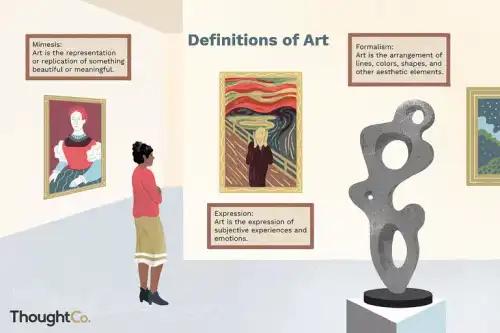Learn more about personaldevelopment with this collection
The importance of perseverance
How to embrace failure as a learning opportunity
The power of innovation and creativity
Discover 128 similar ideas in
It takes just
17 mins to read
Defining Art
- Art does not have a universal definition, though it is generally believed that it is an intentional and conscious creation of something that requires imagination and skill.
- It can be thought of as a symbol of what it means to be human, manifested in physical form for others to see and interpret.
- The word ‘art’ originates from the Latin word ‘ars’ that means skill or craft.
- Art, like beauty, is subjective, and its valuation and definition changes as time goes by.
- To understand art one has to see it’s essential nature and the social impact or importance it generates.
328
1.5K reads
Defining Art Through History
- From the 11th century until the end of the 17th century, the definition of art was anything that was done with expertise, with the result of knowledge and practice.
- The Romantic period of the 18th century, beauty became the main criteria for defining good art. Nature, spirituality and free expression were sought after and well received.
- The 19th Century started the Avant-garde art movement, with art becoming real, modern, futuristic and surreal. Whatever the definitions, the originality of art stands out as a time-tested measure, with new genres and manifestations like performance art, digital art, and electronic art.
252
903 reads
Philosophy of Art
- Art as Representation or Mimesis. Representation of art as an imitation or copying became the mainstream meaning of art in Greece. Plato first developed the idea of art as “mimesis,” which, in Greek, means copying or imitation. How immaculately it replicated the original subject became the measure of its value.
- Art as Expression of Emotional content. Dramatic, sublime and heartfelt art becomes a way to express oneself during the Romantic movement , with audience response becoming key to the valuation of the content. The emotions that were felt when the art was witnessed became its barometer for success.
- Art as Form. Formal qualities of art became influential in the 18th century, with the principles of art and design, like balance, rhythm, harmony and unity became as important as the content of the work of art.
280
819 reads
CURATED BY
More like this
8 ideas
5 ideas
A Beginner’s Guide to Art History
medium.com
8 ideas
Minimalism – Art Term | Tate
tate.org.uk
Read & Learn
20x Faster
without
deepstash
with
deepstash
with
deepstash
Access to 200,000+ ideas
—
Access to the mobile app
—
Unlimited idea saving & library
—
—
Unlimited history
—
—
Unlimited listening to ideas
—
—
Downloading & offline access
—
—
Personalized recommendations
—
—
Supercharge your mind with one idea per day
Enter your email and spend 1 minute every day to learn something new.
I agree to receive email updates




